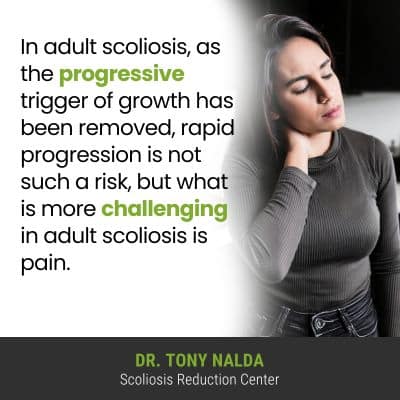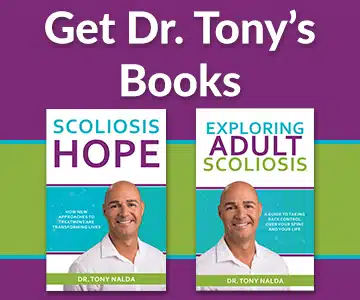Scoliosis is most commonly diagnosed in children, but it also affects adults. In fact, the actual rate of scoliosis increases with age, and that is due to spinal degeneration. The two most common types of scoliosis that affect adults are idiopathic scoliosis and degenerative scoliosis.
Modern conservative adult scoliosis treatment focuses on reducing an unnatural spinal curve back to where it was prior to becoming painful, improving the spine’s support and stability, and pain management. Multiple treatment disciplines are needed to impact conditions on every level.
While the process of treatment for childhood and adult scoliosis is similar, the focus is different so treatment disciplines are apportioned accordingly.
Childhood versus Adult Scoliosis
With the Scoliosis Research Society’s current estimate of close to seven million people living with scoliosis in the United States alone, the condition is highly prevalent and warrants awareness.
Scoliosis causes the spine to develop an unnatural and unhealthy spinal curve that bends to the side and also twists, making scoliosis a 3-dimensional spinal condition.
There are a number of spinal conditions that cause a loss of its healthy curves, but scoliosis is a particularly complex structural spinal condition with characteristics we are still learning about.
Scoliosis can affect babies who are born with the condition (congenital scoliosis), infants (infantile scoliosis), juveniles (early-onset juvenile scoliosis), adolescents (adolescent idiopathic scoliosis), and adult scoliosis is diagnosed in individuals who have reached skeletal maturity.
In addition to different severity levels and types, there are different curvature locations, curvature types and patterns, so no two cases are the same; the complex nature of the condition necessitates the complete customization of treatment plans.
Childhood scoliosis is different in a number of ways, but two main ways the experience differs is in terms of progression and pain.
Progression

As a progressive condition, the nature of scoliosis is to get worse over time, and that means the size of the unnatural spinal curve is getting larger, as are the condition’s uneven forces, and their effects.
While we don’t always know what triggers idiopathic scoliosis to develop initially, we do know that it’s growth that makes it progress, so the more growth a patient has left to go through prior to reaching skeletal maturity, the more potential progression there is yet to face.
Adolescent idiopathic scoliosis, diagnosed between the ages of 10 and 18 is the most prevalent condition type, and this age group is the most at risk for rapid-phase progression due to the rapid and unpredictable growth spurts of puberty.
In adult scoliosis, as the progressive trigger of growth has been removed, rapid progression is not such a risk, but what is more challenging in adult scoliosis is pain.
Pain
While childhood scoliosis isn’t commonly painful, pain is the main symptom of scoliosis in adults; in children, it’s postural changes like uneven shoulders, uneven shoulder blades, the development of a rib cage arch, etc.)
Once skeletal maturity has been reached in adulthood, scoliosis becomes a compressive condition, and that means uneven forces are affecting the spine and its surrounding muscles and nerves.
Scoliosis pain in adults can involve back pain, muscle pain, and/or pain that radiates into the extremities due to nerve compression.
In children who are still growing, their spines are experiencing a constant lengthening motion that counteracts the compressive force of the unnatural spinal curve, and it’s compression of the spine and its surrounding muscles and nerves that causes the majority of condition-related pain.
So while children can experience varying degrees of muscle pain, there doesn’t have to be such a focus on pain management when treating childhood scoliosis versus adult scoliosis.
So as these two important condition characteristics differ between children and adults, the focus of treatment also differs.
Modern Conservative Adult Scoliosis Treatment
While traditional scoliosis treatment has been around for many years, that doesn’t mean it’s the best or only treatment option available to adults, and as scoliosis treatment is about managing a life-long condition, how the spine responds will shape its long-term health and function.
Traditional scoliosis treatment is more reactive than proactive; it doesn’t have a strategy for addressing scoliosis while mild so observes, applies bracing, and then when/if a condition progresses into the severe classification, surgery is commonly recommended.
Spinal fusion surgery is a costly, invasive, and risky procedure that should be considered carefully, and while it can straighten a bent spine, the way it does so is contrary to the spine’s movement-based design so can come at a cost.
In addition, the risks of spinal surgery increase with age and with each subsequent procedure.
The risks of spinal fusion include those associated with the procedure itself, and the long-term effects to spinal strength and function.
Adult scoliosis can be treated with a modern conservative treatment approach, and this is what patients of the Scoliosis Reduction Center® benefit from: proactive treatment that’s started as close to the time of diagnosis as possible.
While pain management is a focus, I want to do more than just prescribe pain medications; I want to impact the underlying cause of the pain: the structural nature of scoliosis itself.
While working towards a significant curvature reduction to counteract the progressive trigger of growth is a focus in childhood scoliosis treatment, in adults, the goal is still to reduce the curve, but back to where it was prior to becoming painful; adult curve reductions don’t have to be as significant because they don’t have to counteract growth.
Adult Idiopathic Scoliosis Treatment
Cases of idiopathic scoliosis in adults are cases of adolescent idiopathic scoliosis that weren’t diagnosed or treated during adolescence, and this is a common scenario that adults are diagnosed once skeletal maturity has been reached and conditions become painful.
Early detection of childhood scoliosis can be a challenge because as it’s not yet compressive, it’s not commonly painful for children, and mild forms aren’t associated with functional deficits, and even postural changes in children can be subtle.
Idiopathic scoliosis is the most common type to affect adults, and treatment will focus on reducing the curve, managing pain, and increasing the spine’s support and stability.
Bracing can also be used for treating adults, and corrective bracing can help with pain management, increasing spinal stability, and augmenting corrective treatment results.

After idiopathic scoliosis, the most common type to affect adults is degenerative scoliosis.
Degenerative Scoliosis Treatment
Degenerative scoliosis affects older adults and is more common in females; this is due to changes in bone density and hormones related to menopause.
Degenerative scoliosis is caused by natural age-related spinal degeneration, along with the cumulative effect of certain lifestyle factors, and the focus of degenerative scoliosis treatment differs slightly because of patient age.
While the progressive trigger of growth has been removed, adult scoliosis still progresses, and once spinal degeneration has started, progressive rates can increase as the spine gets increasingly unbalanced and unstable.
Most spinal degeneration starts with the intervertebral discs, which as they start to degenerate, often change shape, and this affects the position of adjacent vertebrae that attach to the disc in between.
Conservative degenerative scoliosis treatment has the goal of increasing spinal support and stability, pain management, and improving quality of life.
Bracing can help with short-term pain management and increasing spinal stability, and gentle and precise chiropractic adjustments can help keep the spine as loose and flexible as possible.
Increasing core strength can be helpful so the spine’s surrounding muscles can optimally support it.
Treatment for degenerative scoliosis will be customized to suit a patient’s ability, experienced symptom, and condition severity.
Conclusion
What a person can expect from adult scoliosis treatment will depend on the individual in question, but in general, if a modern conservative treatment approach is chosen, proactive treatment can help manage pain, increase spinal support and stability, and reduce curves back to where they were prior to becoming painful.
Traditional adult scoliosis treatment funnels patients towards invasive spinal fusion surgery, and the older a patient is, the more risky surgery becomes, and if the procedure fails for any reason, the only recourse is more surgery, and the risks of spinal surgery increase with each subsequent procedure.
Once a spine is fused, it’s fused for life, and conservative treatment offers a more-natural approach to scoliosis treatment that is more aligned with the spine’s movement-based design.
The success of modern conservative scoliosis treatment shows that many cases of scoliosis don’t require surgical intervention, and here at the Scoliosis Reduction Center®, my adult patients benefit from conservative treatment that works towards preserving as much of the spine’s natural strength and function as possible.




